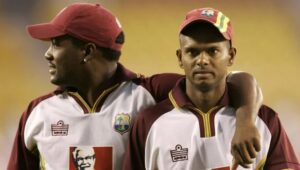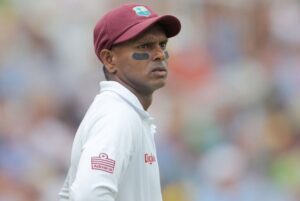Trials and triumphs of ‘Mr. Dependable’
- The biography of Guyanese batsman Shivnarine Chanderpaul
Right there in the foreword of the book, Tiger! Tiger! Burning Bright, you get the immediate sense of the current slump in West Indies cricket.
It is the story of the success of the man they called the “Tiger”, in a period distinctly similar to the doom and gloom cricket lovers are once again experiencing at the hands of one of the region’s most critical institutions.
Deryck Murray, former West Indies wicket-keeper and later national diplomat in Trinidad and Tobago, comments on the contributions of Guyanese batsman Shivnarine Chanderpaul. This is the mid-1990s. “Shiv’s individual success is all the more remarkable when placed in the context of the turmoil of West Indies cricket, during much of his time on the team,” Murray says. “There was increasing disharmony between the players and administrators, and West Indies Cricket was losing its hard-earned lustre.
“Even at the beginning of his career, it was obvious that the team was not performing as a No 1 ranking implied, yet it took defeat by Australia in 1995 to be ‘officially’ recognised. Almost immediately thereafter, West Indies Cricket was in free fall reaching a No 8 ranking.”
Murray wraps up his testament to the “Tiger” by saying Chanderpaul’s perspective shared in the publication may not have provided answers to what the problems there may have been then, but it certainly provides important information, and lessons, which he (Murray) felt would be useful to anyone with responsibility for charting the way forward for West Indies cricket.
“The descent from a number one ranking into the lower echelons was a virtual free-fall, Murray said. “The journey back to the top will be long and arduous—so it is important to go ‘back to the basics’ armed with the experience of the immediate past.”
Point is, however, we are right back to such a period, and for this and other reasons, it is providently instructive to be considering the “Chanders” story, at this a similar juncture in the fortunes of one of the most prized symbols of those totems which hold the West Indian nation together.

Discipline and deep desire
Publisher Clifford Narinesingh says the following in the foreword, to what he himself has had the pleasure, the honour and the responsibility for producing.
“What emerges is the ascendency of an individual whose skill, application, discipline and deep desire to achieve for his self-esteem, team, country and region. Such a career deserves recognition and serves as a model for generations of youth to consider, not only in sport but (in) their various paths in life.”
This, however, is the blanket takeaway. “The overriding theme details the cricketing performance of one whose challenge was to save his team from the abyss into which it was falling.”
Some of those witness to it, those among us across the region who have some of the details and the stats at their fingertips, could fall back on some of what Edmund Blunden described in the opening chapter.
“Shiv’s debut appearance in this 1994 series was remarkable and memorable. It was not just a brilliant debut but he was witness to events which inspired him for the rest of his life. Here he was, in the midst of Lara’s ascendancy as he partnered Lara to the historic feat of surpassing Gary Sobers’ record of the highest individual score in Test cricket. He was in the presence of established players such as Desmond Haynes, Richie Richardson, Courtney Walsh and Curtly Ambrose. He was part of the team in which Ambrose devastated the English batsmen for a mere 46, their lowest Test score. It was a defining debut which gave him lessons and inspiration to progress.”
Blunden reminds readers of the subsequent matches, at Kensington Oval in Barbados and at the Queen’s Park Oval in Port of Spain, at which the West Indies team just continued to pile on the pressure.
At Kensington, Blunden reminds the reader, “Shiv’s role was significant, as he had saved the prospect of a follow-on with his top score of 77. In doing so he salvaged some respectability for his team.”
Then comes the final Test in the series, the Antigua demolition, you might call it, when Lara went after breaking Sir Gary Sobers’ long-standing record of 365 not out, until then the highest single batting score in Test. It has remained on the books for 36 years.

“It was a test not only of Lara’s batting, but also of his fortitude and strength of will,” Blunden remembered. It was also at this time, he said, that his partner at the other end not only aided but gave mental and emotional support as Lara pursued the record.
He quotes Chanders as saying this. “During the Test in Antigua, it was a touch and go event as Brian was tiring after his 300. He seemed to be losing his focus. He was telling me it was hard to go further. I tried to comfort him—told him to relax and he would reach the record. Just keep fighting. You have reached so far already. You have a little further to go. I remember when he reached the record, people were scampering to the ground. Brian was hugging me. It was very special. I will always remember that milestone. I was happy to be part of it.”
Blunden concludes his contribution in this chapter with the following declaration: “History has revealed that Shiv’s career was propelled by his determination, application and skill, a seriousness of purpose and keenness of discipline—all ingredients for success in any venture.”
As Shiv continued to grow, he said, “The varying forces of success and failure were the challenges he faced. For him there were periods of agony but in the larger equation he emerged a successful, well-developed batsman whose name is well established, recognised and worthy of emulation. He has been made integral to the game, a recognition he richly deserves.”
Love for the game
In the next couple succeeding chapters, we learn quite a bit about Chanders’ earliest experiences, his love and devotion to the game and the work it took to get him to where he wanted to be, as well as the determination of his father and uncle to provide him the support and encouragement he needed.
As early as (age) six or seven, we learn “he was active in pursuit of the game, trying to master the skills of batting and bowling”. He left school at 13, and his days were spent either at cricket practice or working with his dad during his fishing trips. He is quoted saying the following:
“I would wake up in the morning and would prepare to go out to sea. What made it difficult was that it was a sailboat. We had to man the sails, hoist them up, work the rudders and at times I would bail water out from a flooded boat. Some of this I would do almost naked, because I had to preserve my clothes when we were further out to sea and casting the nets. As I got older, I had to man the sails and my hands were then unusually hardened as I had to pull the ropes. This prepared me for the difficult catches I would take during Test matches. My teammates would be surprised to know my hands never hurt on those occasions.”
Later on, we learn of his “remarkable sense of gratitude”, never scorning the “base degree by which he did ascend, always expressing appreciation for all who helped him on his way to a successful career”.
In a chapter titled “Decline Surfaces”, the eminent historian The UWI vice-chancellor Sir Hilary Beckles captures again the state of unease on the one hand, and indiscipline on the other, which had enveloped the West Indies team and their game in particular. He recalled that “this was no climate for the young man”. He had, after all, been selected after eight Test matches as part of the squad. In England, in what was called the “Cornhill Test Series”, his scores were 18, and 5 not out, in the fifth Test. This, Sir Hilary said, “hardly reflected his ability”.

Steeliness of mind and character
Overall, this book on Shivnarine Chanderpaul is a chronicle of West Indies cricket during a period of high-level, low-pedigree misbehaviour among players and selectors alike. It is also, however, the inspirational tale of a man who was on a mission, which he undertook with steeliness of mind and character.
The middle chapter, “Shiv at The Helm”, begins, for instance, with a move by Cable and Wireless to dump the team from its sponsorship. They were described as “weary of failure”, and made way for Digicel, which by then had become their rivals in the region in the telecommunications industry. “Trouble is,” we are told, “six leading players retained personal contracts with C&W”, a situation which the board said ruled them out of contention. The Players Association took issue with it, “and civil war broke out”. Brian Lara, then captain, was not directly affected, but he sided with the players.
“Some sort of temporary truce was eventually brokered when the players terminated their personal contracts, but not in time to prevent a weakened side, under the new captain Shivnarine Chanderpaul,” we are told. In a line-up of tournaments against Australia, South Africa and Pakistan, “Chanders” was reported as saying it was due to the consequence of a disunited bunch of unruly players who were deliberately subverting his leadership.
“They seemed not interested in playing under my captaincy. In Australia it was quite noticeable as umpire Rudy Kursten approached me and spoke to coach Bennett King, telling him about the players’ behaviour on the field.”
He goes further, recalling instances in which it was made clear to him how unmistakenly the knives were drawn against him.
In one game in the regional tournament, Guyana versus Jamaica, “when Chris Gayle was aggressive, hitting the ball one bounce to the boundary”, he had put a man at backward point, “and in no time we got Gayle”.
But Colin Croft, from the commentary box, was not impressed. He described what he saw from “Chanders” as the worst field placing he had seen in his career.
“I had been captain of Guyana’s team for ten years, and I know about captaincy,” Chanderpaul protested to someone afterwards.
“I also recall after my award from The UWI St Augustine, Colin Croft saw me on a plane flight and ignored me.”
With opposition coming from elsewhere among leading members of the team, he confessed to having given thought to relinquishing the captaincy. (Trinidad Express)






I love these comments about West Indies Cricket which is now in the doghouse having lost their lustre.
Love of CRICKET IS NOT THERE ANYMORE. Watch how insane amount of money are paid to some who think they are great cricketers when in fact they are just playing BAT and BALL like schoolboys learn at an early age.
They think 20, 30, 15, 60 overs matches for money is CRICKET. No, it is gambling. They can’t last 5 days playing TEST MATCH CRICKET.